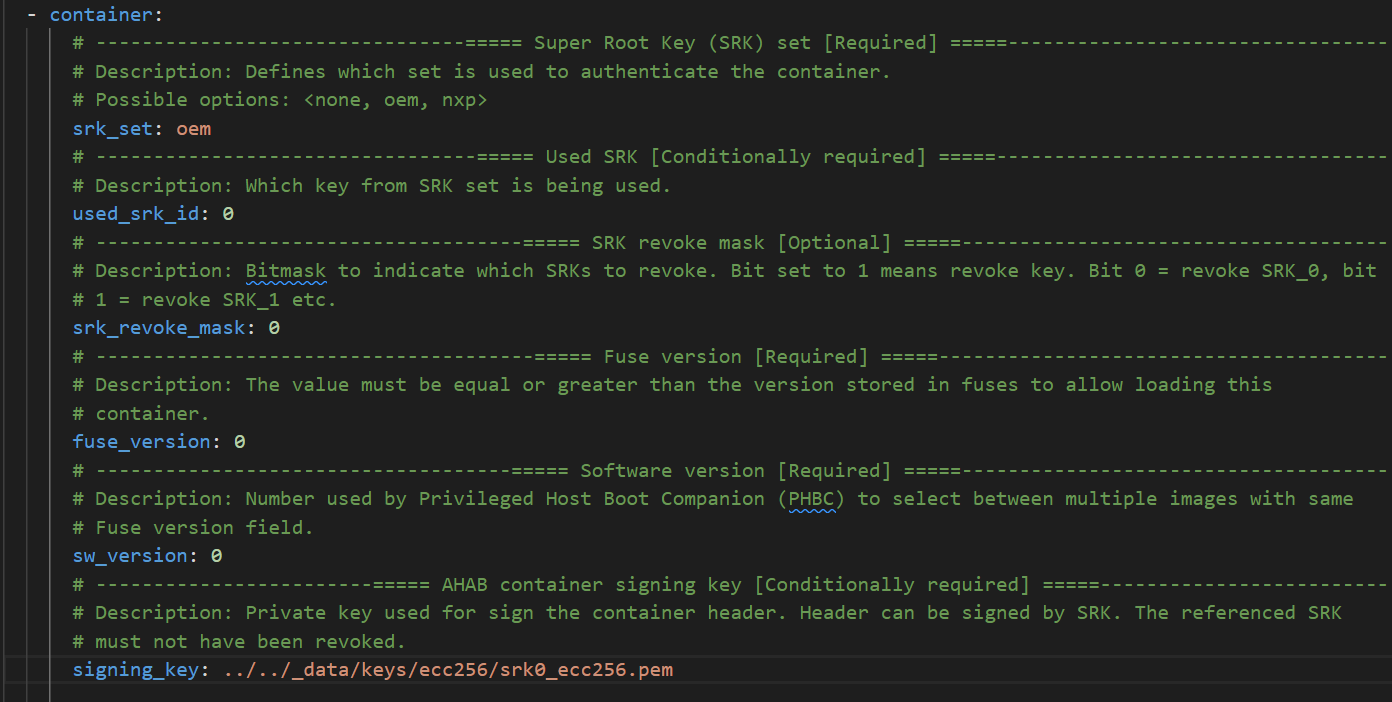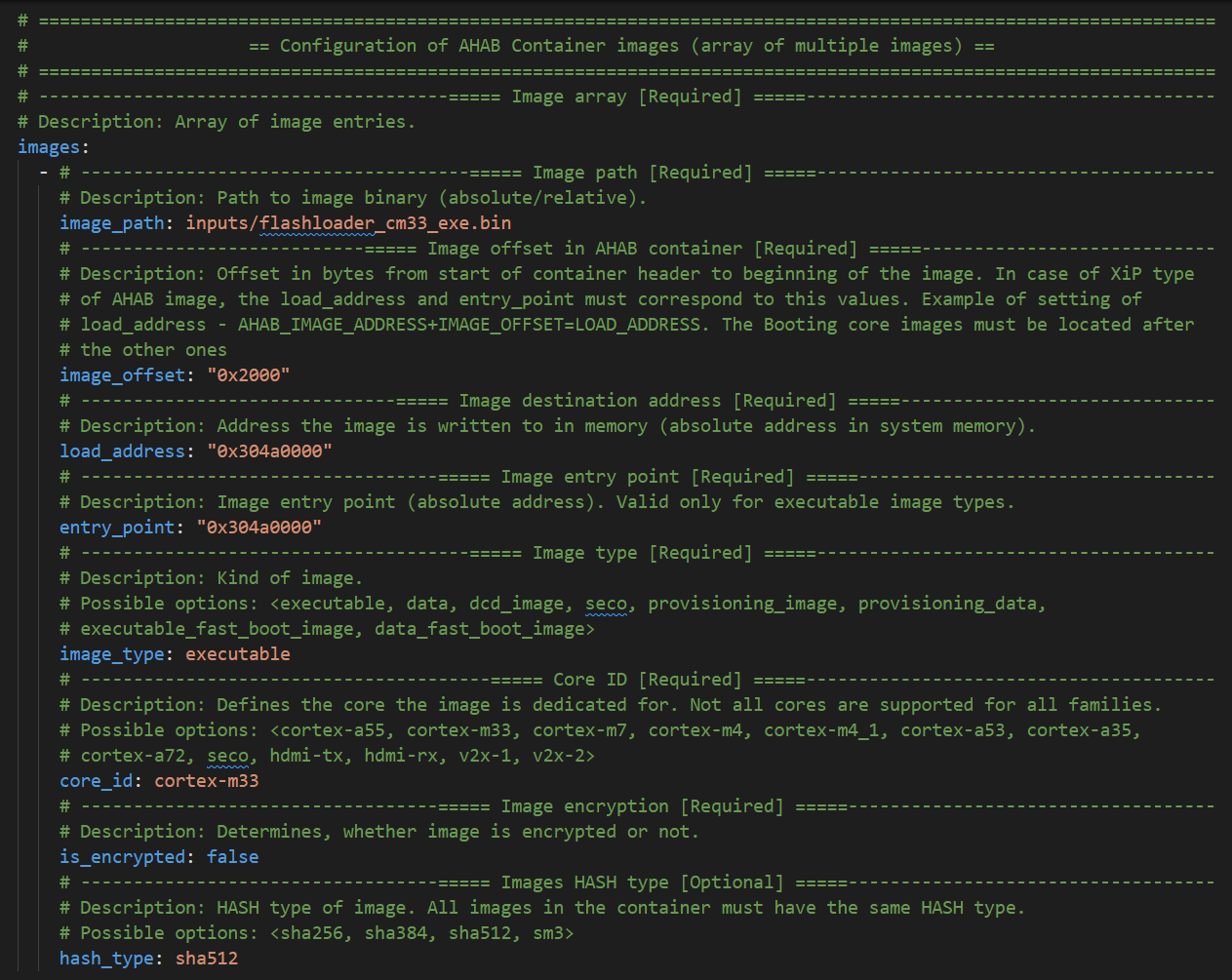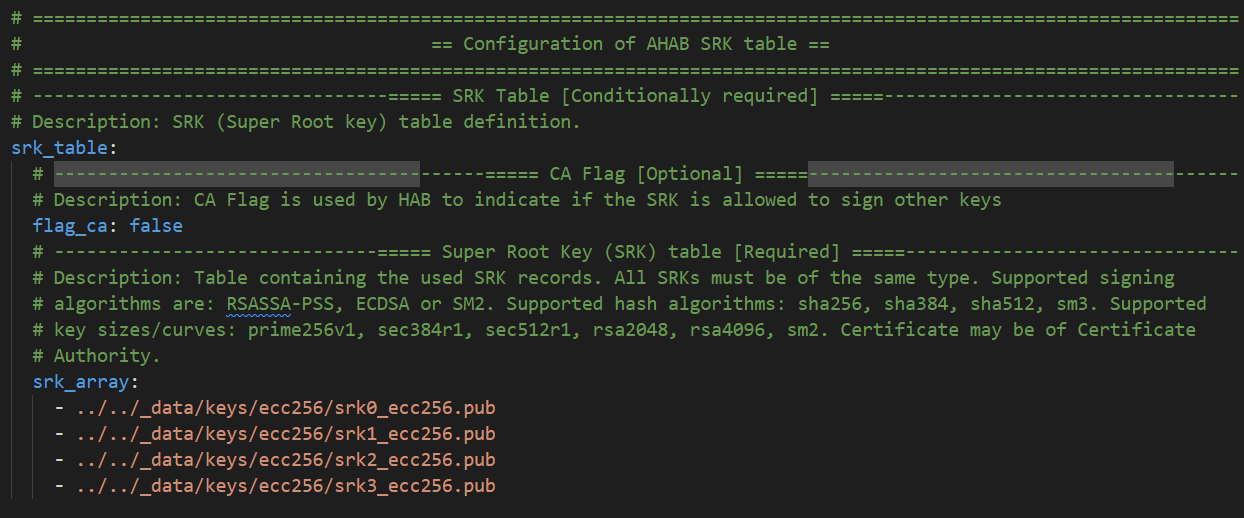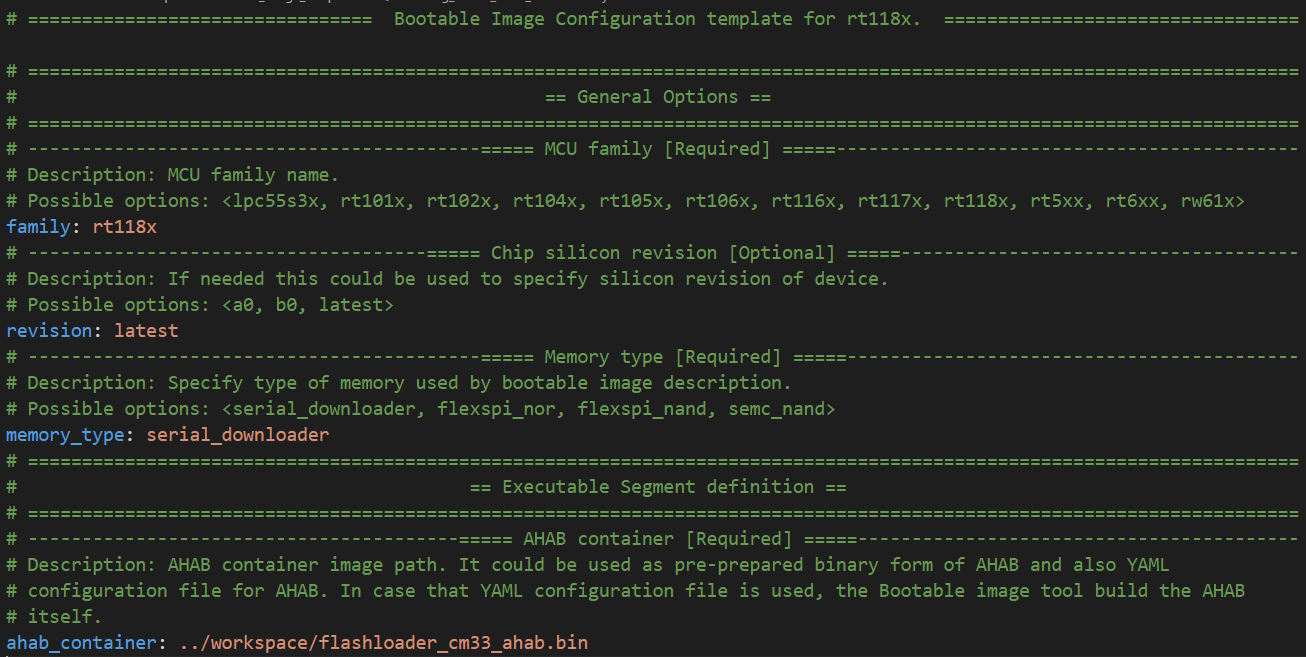i.MXRT118x signed flashloader example#
This is example how to create signed flashloader for i.MXRT118x device with EdgeLock firmware included. The aim of this Jupyter notebook is show how to easily create AHAB container with flashloader application from NXP SDK to be loaded with serial downloader mode. The process could be split to several steps.
1. Compile the flashloader application#
As a first step is needed to compile flashloader application itself from NXP SDK. - Download the NXP MCUXpresso SDK from NXP web site (https://mcuxpresso.nxp.com/) - Open the flashloader application in your favorite IDE. (Regular path to application: {SDK_root}\boards\evkmimxrt1180\bootloader_examples\flashloader\cm33) - Compile the flashloder and generate the binary output (In our example we use precompiled flashloader_cm33_exe.bin)
2. Prepare the AHAB configuration file#
Run this code to initialize members for this example…
%run ../../init_notebook.ipynb
import os
import pprint
pp = pprint.PrettyPrinter(indent=4)
WORKSPACE = "workspace/" # change this to path to your workspace
VERBOSITY = "-v" # verbosity of commands, might be -v or -vv for debug or blank for no additional info
TEMPLATE_FILE = WORKSPACE + "ahab_template.yaml" # AHAB configuration template file
BIMG_TEMPLATES_PATH = WORKSPACE + "bootable_image_templates" # Bootable image templates folder
FLSHLDR_EXE_PATH = "inputs/flashloader_cm33_exe.bin" # Input compiled flashloader executable in binary format
AHAB_CONFIG = "inputs/flashloader_cm33_cfg.yaml" # Prepared AHAB configuration file
AHAB_FILE = WORKSPACE + "flashloader_cm33_ahab.bin" # File name of created signed AHAB container with flashloader and EdgeLockEnclave firmware
BOOTIMG_CONFIG = "inputs/bootimg_rt118x_serial_downloader.yaml" # Prepared Bootable image configuration file
FLASHLOADER = WORKSPACE + "flashloader.bin" # Final Bootable flashloader
env: JUPYTER_SPSDK=1
Created `%!` as an alias for `%execute`.
To get all supported sub commands of AHAB support call help.
%! nxpimage ahab
nxpimage ahab
Usage: nxpimage ahab [OPTIONS] COMMAND [ARGS]...
Group of sub-commands related to AHAB.
Options:
--help Show this message and exit.
Commands:
certificate Group of sub-commands related to AHAB certificate blob.
export Generate AHAB Image from YAML/JSON configuration.
get-template Create template of configuration in YAML format.
parse Parse AHAB Image into YAML configuration and binary...
update-keyblob Update keyblob in AHAB image.
As a good starting point it could be creation of AHAB configuration YAML file template#
# Create template AHAB configuration file using nxpimage
%! nxpimage $VERBOSITY ahab get-template -f rt118x -o $TEMPLATE_FILE --force
assert os.path.exists(TEMPLATE_FILE)
nxpimage -v ahab get-template -f rt118x -o workspace/ahab_template.yaml --force
Creating C:\_DDM\GIT\PROVISIONING\spsdk\examples\flashloader\ahab\workspace\ahab_template.yaml template file.
Modify the template to configuration file used to create AHAB flashloader as a serial downloader mode#
Change the Target memory to serial downloader

Change the output file name

Define the path to the EdgeLock Enclave Firmware container (And clean up the comments about possible options of container definitions)

Add to list of containers the Flashloader container definition

Define the general definition of Flashloader container. In our example the signature provider definition is removed and the local private signing key is defined

Define the image executable (compiled flashloader binary), On the offset doesn’t matter in serial downloader mode, it’s updated automatically. The most important are ‘load_address’ and ‘entry_point’ fields that must be sets on same value as is defined linker file for the application start of the application. The unused optionally fields has been removed from config. In case of i.MXRT118x the linker load address is 0x304a0000.

Define the SRK (Super Root Keys) record. In our case the locel pregenerated public keys.

And finally remove unused parts for AHAB Certificate and Encryption blob
3. Export the AHAB container#
To export AHAB container is designed SPSDK tool in ‘nxpimage’ under ‘ahab’ sub commands group.
# Export AHAB container using nxpimage
%! nxpimage $VERBOSITY ahab export -c $AHAB_CONFIG
assert os.path.exists(AHAB_CONFIG)
nxpimage -v ahab export -c inputs/flashloader_cm33_cfg.yaml
INFO:spsdk.apps.nxpimage:Created AHAB Image:
Name: AHAB Image
Starts: 0x0
Ends: 0x19c17
Size: Size: 105.5 kB; 105,496 B
Alignment: 1 B
AHAB Image for rt118x_b0
INFO:spsdk.apps.nxpimage:Created AHAB Image memory map:
+==0x0000_0000= AHAB Image =======================+
| Size: 105.5 kB; 105,496 B |
| AHAB Image for rt118x_b0 |
|+==0x0000_0000= AHAB Container 0 ===============+|
|| Size: 544 B ||
|| AHAB Container for nxp_SWver:0 ||
|+==0x0000_021f==================================+|
| Gap: 480 B |
|+==0x0000_0400= AHAB Container 1 ===============+|
|| Size: 544 B ||
|| AHAB Container for oem_SWver:0 ||
|+==0x0000_061f==================================+|
| Gap: 6.6 kB |
|+==0x0000_2000= Container 0 AHAB Data Image 0 ==+|
|| Size: 9.5 kB; 9,456 B ||
||AHAB encrypted data block with seco Image Type.||
|+==0x0000_44ef==================================+|
|+==0x0000_44f0= Container 1 AHAB Data Image 0 ==+|
|| Size: 87.8 kB; 87,848 B ||
|| AHAB data block with executable Image Type. ||
|+==0x0001_9c17==================================+|
+==0x0001_9c17====================================+
Success. (AHAB: C:/_DDM/GIT/PROVISIONING/spsdk/examples/flashloader/ahab/workspace/flashloader_cm33_ahab.bin created.)
Generated SRK hash files (c:\_DDM\GIT\PROVISIONING\spsdk\examples\flashloader\ahab\flashloader_cm33_ahab_oem1_srk_hash*.*).
4. Make Bootable image#
To proper load of created flashloader over serial downloader mode, the bootable image must be created. In case of serial downloader the bootable image is composed from XMCD block (up to 1KB, 0x400B) and the AHAB image itself. The SPSDK contains commands group that simplify whole operation with bootable images under ‘nxpimage’. To list all supported subcommands call help for this subgroup:
# Get help for bootable image to list all supported commands
%! nxpimage bootable-image
nxpimage bootable-image
Usage: nxpimage bootable-image [OPTIONS] COMMAND [ARGS]...
Group of bootable image utilities.
Options:
--help Show this message and exit.
Commands:
fcb FCB (Flash Configuration Block) utilities.
get-templates Create template of configurations in YAML format from...
merge Merge boot image blocks into one bootable image.
parse Parse Bootable Image into YAML configuration and binary...
xmcd XMCD (External Memory Configuration Data) utilities.
As a good starting point it could be creation of Bootable Image configuration YAML file template#
# Get the template file of configuration for bootable image
%! nxpimage $VERBOSITY bootable-image get-templates -f rt118x -o $BIMG_TEMPLATES_PATH --force
nxpimage -v bootable-image get-templates -f rt118x -o workspace/bootable_image_templates --force
Creating C:\_DDM\GIT\PROVISIONING\spsdk\examples\flashloader\ahab\workspace\bootable_image_templates\bootimg_rt118x_serial_downloader.yaml template file.
Creating C:\_DDM\GIT\PROVISIONING\spsdk\examples\flashloader\ahab\workspace\bootable_image_templates\bootimg_rt118x_flexspi_nor.yaml template file.
Creating C:\_DDM\GIT\PROVISIONING\spsdk\examples\flashloader\ahab\workspace\bootable_image_templates\bootimg_rt118x_flexspi_nand.yaml template file.
Creating C:\_DDM\GIT\PROVISIONING\spsdk\examples\flashloader\ahab\workspace\bootable_image_templates\bootimg_rt118x_semc_nand.yaml template file.
From the Bootable image templates folder copy and modify the ‘bootimg_rt118x_serial_downloader.yaml’ file. In our case we have to solve just two options:
Remove XMCD block section from configuration file (no custom XMCD will be used)
Modify the AHAB container file name

Export the final bootable image#
# Export bootable image
%! nxpimage $VERBOSITY bootable-image merge -c $BOOTIMG_CONFIG -o $FLASHLOADER
assert os.path.exists(FLASHLOADER)
nxpimage -v bootable-image merge -c inputs/bootimg_rt118x_serial_downloader.yaml -o workspace/flashloader.bin
INFO:spsdk.apps.nxpimage:Created Bootable Image:
Name: Bootable Image for rt118x
Starts: 0x0
Ends: 0x1a017
Size: Size: 106.5 kB; 106,520 B
Alignment: 1 B
Pattern:zeros
Memory type: serial_downloader
Revision: b0
INFO:spsdk.apps.nxpimage:Created Bootable Image memory map:
+==0x0000_0000= Bootable Image for rt118x ==+
| Size: 106.5 kB; 106,520 B |
|Memory type: serial_downloader Revision: b0|
| Pattern: zeros |
| Gap: 1.0 kB |
|+==0x0000_0400= ahab_container ===========+|
|| Size: 105.5 kB; 105,496 B ||
|+==0x0001_a017============================+|
+==0x0001_a017==============================+
Success. (Bootable Image: C:\_DDM\GIT\PROVISIONING\spsdk\examples\flashloader\ahab\workspace\flashloader.bin created.)
5. Generated flashloader file load to i.MXRT118x#
As a final step is load flashloader into MCU and run. The easiest way is get ‘blhost’ application and ‘load-image’ command.
Chip must be in serial downloader mode!
Here is two examples how to do it over Serial line or USB:
blhost -p com1 load-image workspace/flashloader.bin
blhost -u 0x1fc9:0x014c load-image workspace/flashloader.bin